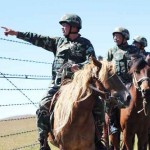Started in 1600 as a company with shareholders to peacefully and profitably develop trade with the Asian continent, the East India Company was no longer a trading concern by the beginning of the nineteenth century, but rather the military arm of the British Empire and “the authorised ruler of the vast Indian subcontinent and various other possessions.”
Click to buy: Tibet: The Lost Frontier
Younghusband described the manner in which British officers of the Company worked for nearly three centuries to expand their empire:
“…We who have dealt with Asiatics can appreciate so well [the following tactic] taking the opportunity, striking while the iron is hot, not letting the chance go by, knowing our mind, knowing what we want, and acting decisively when the exact occasion arises.”1
It was Warren Hastings who first saw the importance for British trade of securing some sort of friendship with Tibet.
Though recognizing the wrong action of the Bhutanese king, the Panchen Lama pleaded with Hastings for clemency ““ it was the first letter from a Tibetan Lama to a British officer.
The Company had opened trading posts in Madras and Calcutta and later started penetrating China, taking tea, silk, porcelains or cottons back to England on the return voyage. An ever-expanding Empire!
Regarding Tibet and the Himalayan states, Hastings bided his time until the right opportunity came to advance his pawn and ‘strike while the iron was hot’.
It came in 1772, when the Bhutanese attacked Cooch Behar2 and took its King prisoner. There was no hesitation in Hastings’ mind. He retaliated against the Bhutanese, defeating them. At that point, the opportunity to enter into contact with Tibet emerged. One hundred and thirty years later, Younghusband thus described Hastings’ actions:
“It was a forward policy, and combined in a noteworthy manner alertness and deliberation, rapidity and persistency, assertiveness and receptivity. He sought to secure his borders by at once striking when danger threatened, but also by taking infinite pains over long periods of time to promote ordinary neighbourly intercourse with those on the other side. Both qualities are necessary.”
The opportunity to enter into contact with Tibet came in the form of a letter from the Panchen Lama who was the guru of the ruler of Bhutan. Though recognizing the wrong action of the Bhutanese king, the Panchen Lama pleaded with Hastings for clemency – it was the first letter from a Tibetan Lama to a British officer.
“¦refer the matter to the Regent and the Kashag in Lhasa who opposed the idea as it would have upset the fragile balance with the Chinese authorities.
The Tashilhunpo monastery was much less isolated than Lhasa. India’s ‘proximity’ would be used by British officers in their ‘forward policy’ till the middle of the twentieth century. The Chinese Amban in Lhasa and the presence of many Chinese monks in the great monasteries around Lhasa were other factors which contributed to the isolation of the Tibetan capital.
Hastings laid the letter of the Panchen Lama before the Board of the Company in Calcutta and informed them that he proposed a general treaty of amity and commerce between Bengal and Tibet. For the purpose, George Bogle, a twenty-eight year old officer was chosen by the Viceroy to be the first British Agent at the Court of the Panchen Lama. He left the same year for Shigatse to negotiate with the Lama.3
Bogle’s discussions with the Tashi Lama,4 revolved around a possible alliance between Tibet and British India, “so that the influence of the latter might be used to restrain the Gurkhas of Nepal from attacking Tibet.”5
The Tashi Lama was quite open to the arguments of Bogle, but he had to refer the matter to the Regent and the Kashag in Lhasa who opposed the idea as it would have upset the fragile balance with the Chinese authorities. The Regent diplomatically wrote that he needed to get a clearance from Peking which, for obvious reasons, never came.
The entry of a new player in the game was not well received by the old players. The Nepalese were not keen to see an alliance between Tibet and India with their kingdom suddenly sandwiched between two powerful neighbours
The entry of a new player in the game was not well received by the old players. The Nepalese were not keen to see an alliance between Tibet and India with their kingdom suddenly sandwiched between two powerful neighbours. The Gurkha King took the matter to the Tashi Lama, assuring him that Tibetans had nothing to fear from the Nepalese6 and that he would keep a friendly attitude towards the Tashi Lhunpo. He also warned that if Bogle was thinking of war, the Nepalese were well prepared and Kathmandu, like Lhasa, wanted to keep the British out of their territory.
The Nepalese king concluded his letter requesting the Tibetan Lama “to have no connection with the Firingies (English) or Moguls and not to allow them into the country, but to follow the ancient custom (to keep the foreigners out).”7
Bogle had many friendly discussions with the Panchen Lama but he finally had to leave the Land of Snows. He later learned that his appeal to the Lhasa Government to receive him, had been rejected. However, before he left Shigatse, Bogle met with many traders from Kashmir and Tibet who told him how keen they were to start business with British India.
The influence of the Manchus’ representatives in Lhasa forced Tibet to remain a closed country; this situation was to continue until the beginning of the twentieth century.




